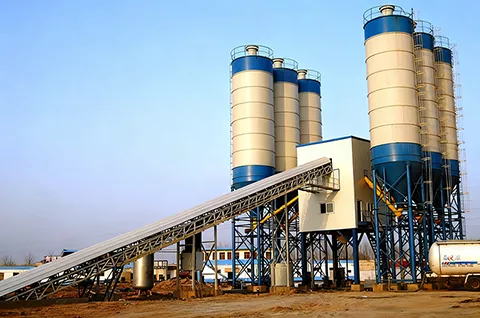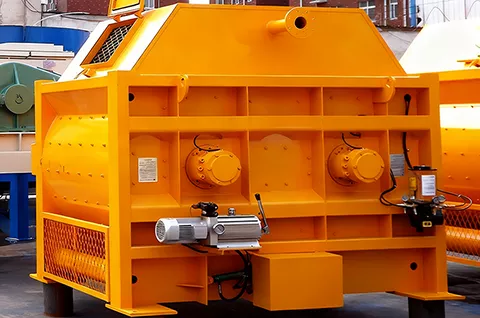What is a Trailer Concrete Pump?
A trailer concrete pump is a type of concrete pumping equipment mounted on a trailer chassis. It does not have its own power source and needs to be towed to the construction site by a truck, tractor, or other towing vehicle. Its main function is to continuously deliver ready-mixed concrete through a pipeline system to designated locations, especially those areas that mixer trucks cannot directly reach or where vertical and long-distance horizontal conveying is required.
A trailer concrete pump is sometimes also called a towable concrete pump or trailer-mounted line pump. It is widely used on construction sites, bridge projects, and other similar applications.
Unlike truck-mounted boom pumps equipped with large telescopic booms, trailer concrete pumps typically use flexible hoses and/or rigid pipelines instead of booms. They are particularly suitable for job sites with limited space where mixer trucks cannot directly access the pouring point.
Haomei Concrete Pump Trailer for Sale
- Z – stands for Gate Valve Pump
- C – stands for Electric Pump
- D – stands for Diesel Pump
- S – stands for S-Valve Pump
- R – stands for Diesel Power
-
 HBT60S1413-90 Trailer Concrete Pump
HBT60S1413-90 Trailer Concrete Pump
Theory Concrete Output: 60m³/h | Power: 90KW
-
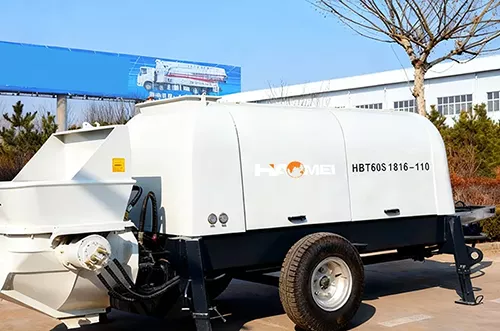 HBT60S1816-110 Trailer Concrete Pump
HBT60S1816-110 Trailer Concrete Pump
Theory Concrete Output: 60m³/h | Power: 110KW
-
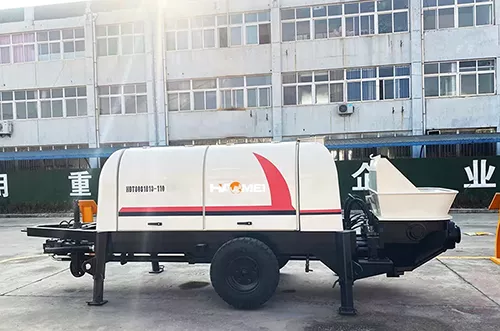 HBT80S1813-110 Trailer Concrete Pump
HBT80S1813-110 Trailer Concrete Pump
Theory Concrete Output: 80m³/h | Power: 110KW
-
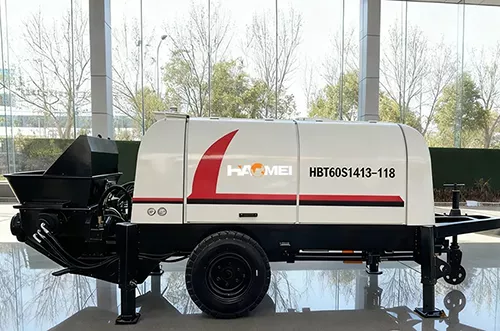 HBT60S1413-118R Trailer Concrete Pump
HBT60S1413-118R Trailer Concrete Pump
Theory Concrete Output: 60m³/h | Power: 118KW
-
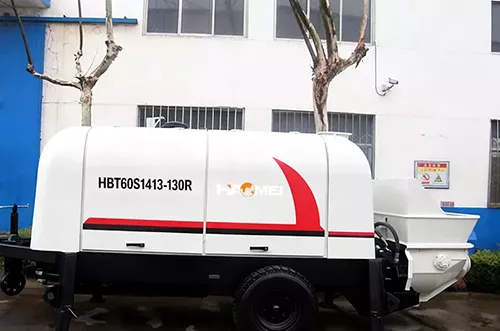 HBT60S1413-130R Trailer Concrete Pump
HBT60S1413-130R Trailer Concrete Pump
Theory Concrete Output: 60m³/h | Power: 130KW
-
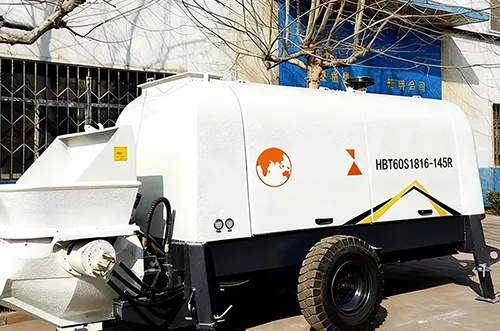 HBT60S1816-145R Trailer Concrete Pump
HBT60S1816-145R Trailer Concrete Pump
Theory Concrete Output: 60m³/h | Power: 145KW
-
 HBT60S1816-174R Trailer Concrete Pump
HBT60S1816-174R Trailer Concrete Pump
Theory Concrete Output: 60m³/h | Power: 174KW
-
 HBT80S1813-145R Trailer Concrete Pump
HBT80S1813-145R Trailer Concrete Pump
Theory Concrete Output: 80m³/h | Power: 145KW
-
 HBT80S1813-174R Trailer Concrete Pump
HBT80S1813-174R Trailer Concrete Pump
Theory Concrete Output: 80m³/h | Power: 174KW
-
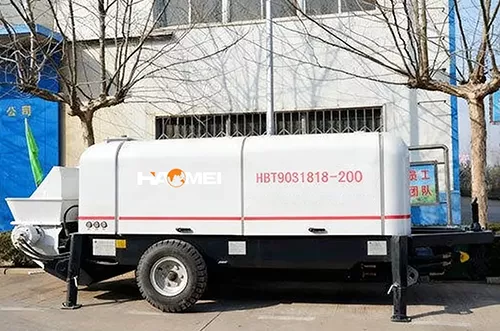 HBT90S1818-200R Trailer Concrete Pump
HBT90S1818-200R Trailer Concrete Pump
Theory Concrete Output: 90m³/h | Power: 200KW
Concrete Pump Trailer Technical Parameters
The main parameters of a trailer concrete pump are: delivery capacity, outlet pressure, power, and the type of distribution valve.
| Model | Theoretical Concrete Output (m³/h) | Concrete distribution valve | Cylinder Stroke (mm) | Outlet Pressure (MPa) | Motor/Diesel Power (kW) |
| HBT60S1413-90 | 60 | S | 1400 | 13 | 90 |
| HBT60S1816-110 | 60 | S | 1800 | 16 | 110 |
| HBT80S1813-110 | 80 | S | 1800 | 13 | 110 |
| HBT60S1413-118R | 60 | S | 1400 | 13 | 118 (Diesel) |
| HBT60S1413-130R | 60 | S | 1400 | 13 | 130 (Diesel) |
| HBT60S1816-145R | 60 | S | 1800 | 16 | 145 (Diesel) |
| HBT60S1816-174R | 60 | S | 1800 | 16 | 174 (Diesel) |
| HBT80S1813-145R | 80 | S | 1800 | 13 | 145 (Diesel) |
| HBT80S1813-174R | 80 | S | 1800 | 13 | 174 (Diesel) |
| HBT90S1818-200R | 90 | S | 1800 | 18 | 200 (Diesel) |
When choosing a trailer concrete pump, some important specifications include:
- Output capacity (e.g., cubic yards or cubic meters per hour) — the amount of concrete pumped.
- Pumping pressure — the higher the pressure, the longer or higher the delivery distance.
- Maximum horizontal and vertical conveying distance — the maximum distance the concrete can be transported.
- Aggregate size compatibility — the maximum size of stone/aggregate the pump can handle.
- Power source (diesel or electric) — depending on site conditions and cost.
How does a concrete pump trailer work?
- The trailer concrete pump is installed on site — it is towed in, leveled, and fixed on stable ground.
- Concrete is discharged from the mixer truck or batching plant into the pump’s hopper.
- The pump uses hydraulic power and a valve system (such as the S-valve) to push the concrete through connected hoses or pipelines to the pouring point.
- The operator monitors pressure and flow, ensuring the pipeline is clear and well lubricated to prevent blockages.
- After pouring is complete, the hopper, pumping unit, and pipelines are cleaned to prevent residual concrete from hardening.
Advantages of Trailer Concrete Pump
- High mobility: The biggest advantage is that it can be towed to different construction sites, making it ideal for small and medium-sized, scattered, or rural projects.
- Flexible placement: Suitable for areas where large boom pumps cannot reach (such as backyards, narrow alleys, etc.).
- Cost-effective: Compared with boom pumps, trailer pumps are more economical. They are also much cheaper than truck-mounted pumps.
- Flexible placement: Suitable for areas where large boom pumps cannot reach (such as backyards, narrow alleys, etc.).
- Ideal for small and medium projects, cost-effective: Compared with large boom pumps, trailer pumps usually have lower deployment costs.
- Long conveying distance and high delivery height: With different lengths of pipelines, both long-distance horizontal and vertical pumping can be achieved.
- High efficiency: Mechanized pumping is dozens of times faster than manual transportation or bucket lifting, significantly shortening the construction period.
- Strong adaptability: Can operate in confined spaces or complex terrains; as long as the pipeline can be laid, the concrete can be pumped.
Structure of Trailer Concrete Pump
Trailer chassis: Equipped with wheels and a suspension system for easy transport and mobility.
Hopper: Receives concrete discharged from the mixer truck.
Pumping system:
- Hydraulic system: Provides power, considered the “heart” of the pump.
- Main oil cylinder: Drives the reciprocating motion of the pumping cylinders.
- Delivery cylinder (concrete cylinder): Directly connected to the hopper and S-valve, responsible for pushing the concrete.
S-shaped valve (S-valve): A key distribution valve that swings like a rocker arm, alternately connecting with the two delivery cylinders to ensure continuous, uninterrupted concrete output.
Delivery pipeline: Made of wear-resistant alloy steel, including straight pipes, bends, and flexible hoses, connecting the pump outlet with the pouring point.
Outriggers: Hydraulic or manually operated supporting legs that extend during pumping to stabilize the equipment and bear the reaction force generated during operation.
Applications of Trailer Concrete Pump
- Civil construction: Foundations, slabs, beams, and columns for residential buildings, villas, and low-rise commercial structures.
- Rural construction: Self-built houses, village roads, irrigation facilities, etc., very popular in rural areas.
- Industrial construction: Floors and structural works of factories and warehouses.
- Infrastructure projects: Tunnels, bridges, slope protection, and other concrete pouring projects.
- Others: Any site requiring efficient and continuous concrete delivery, where conditions are complex or boom pumps are not suitable.
Difference Between Trailer Concrete Pump and Truck-Mounted Boom Pump
Trailer concrete pumps are suitable for small to medium-sized or complex terrain sites, have lower costs but require manual pipeline setup.
Truck-mounted boom pumps are highly automated, suitable for large-scale and high-rise projects, and offer higher construction efficiency.
| Features | Trailer Concrete Pump | Truck-Mounted Concrete Pump (Boom Pump) |
| Mobility | Passive movement, requires towing | Self-propelled chassis, highly mobile |
| Boom system | None, requires manual pipeline setup and management | Equipped with hydraulic folding boom, wide placing range |
| Degree of automation | Low, requires manual pipe arrangement and guidance | Very high, boom can be operated remotely |
| Cost | Low purchase cost | Very expensive |
| Suitable scenarios | Small and medium-sized projects, fixed-point concrete pouring | Medium and large projects requiring quick and frequent placement repositioning |
| Preparation work | Pipeline setup takes longer | Once positioned, boom can be unfolded immediately; shorter preparation time |
Trailer Concrete Pump Precautions / Limitations
- Operating range and height limitations: The working range of a trailer concrete pump may not be as large as that of a boom concrete pump. If you need to deliver concrete to very tall buildings or require a wider horizontal pumping range, a boom pump may be necessary.
- Concrete supply requirement: Since a trailer concrete pump does not mix concrete itself, it typically requires a ready-mix concrete truck or a separate mixer to supply concrete. Some machines integrate both mixing and pumping functions, but these belong to a different category.
- Cleaning and maintenance: Timely cleaning of hoses, valve systems, and the hopper is essential; otherwise, blockages or damage may occur.
- Site setup: The trailer concrete pump must be placed on stable, level ground, and the hoses must be laid out securely.
Is pumping concrete better than pouring?
| Aspect | Pumping Concrete | Pouring (Direct Discharge) |
| Speed & Efficiency | Much faster for large or high-rise jobs | Slower, depends on truck positioning |
| Reach & Access | Can place concrete up to 100+ meters horizontally or several floors up | Limited to where the chute can reach |
| Surface Finish & Uniformity | Provides continuous, smooth placement | More stop-start, risk of segregation |
| Labor Needs | Requires fewer workers once set up | More manual effort and coordination |
| Cost | Higher (equipment + setup fees) | Lower (no pump rental) |
| Ideal Use Cases | High-rise buildings, bridges, tunnels, remote sites | Small slabs, driveways, accessible foundations |
Pumping concrete is generally better for large or hard-to-reach projects because it delivers concrete quickly, smoothly, and with less labor, even over long distances or to high places. Direct pouring is simpler and cheaper, but only works well when the mixer truck can get close to the pour site.



